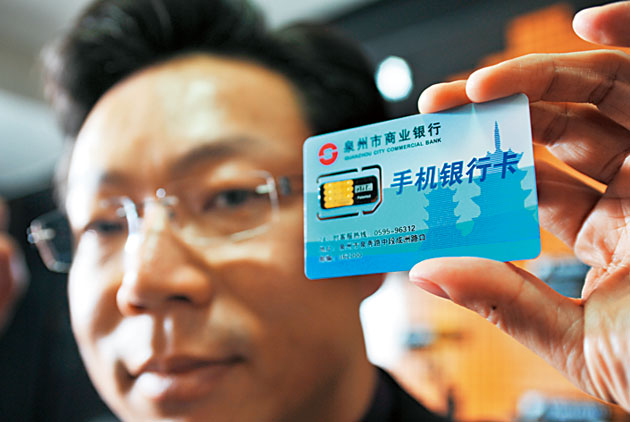Taisys Technologies
Turning a Shack into a Financial Center

Source:CW
A revolutionary membrane no thicker than tin foil is enabling people around the world, from the plains of Africa to Chinese townships, to use their mobile phones for a stunning range of transactions.
Views
Turning a Shack into a Financial Center
By David HuangFrom CommonWealth Magazine (vol. 515 )
It all started on a trip into the mountains.
More than 10 years ago, when Taisys Technologies Co. Ltd. CEO Jason Ho had just started in the telecommunications sector, he was driving in the mountains when he realized his car was low on gas. After a prolonged search, Ho finally found a gas station, only to discover that he had forgotten his wallet. All he had with him was his mobile phone.
"I thought then, wouldn't it be great if I could pay with my cell phone," Ho recalls.
That sudden inspiration led Taisys, a leader in mobile interconnectivity, to actually turn a mobile phone into a bank, an innovation that has helped Africa become the continent with the highest concentration of mobile cash withdrawal machines.
In Africa, finding a lion can be easier than finding an ATM.
"That's not a joke," says Ida Wang, the company's vice president of sales and marketing. "But we wanted to enable a chieftain in his corrugated steel shack, using a smartphone connected to a government welfare department, to transfer funds directly into the phones of the clan's members, making it possible for them to buy goods without cash."
People in Taiwan may have a hard time imagining that the simple task of picking up a government subsidy can be a daunting experience. Just getting to a town's only banking outlet (similar to a post office) may require a two-hour journey. Then there's a chance of getting robbed as one leaves the office, all for a subsidy of 500 South African rand (about NT$1,600).
Wang, who recently returned to Taiwan a few days later than expected from a trip to South Africa after being forced to spend two nights at an airport in Mozambique, truly sympathizes with people in remote areas in the region.
"Taiwan's financial services are really so convenient. Convenience stores at one's doorstep have ATMs, making it hard for us to fathom how important financial services really are," Wang says.
Establishing a bank or setting up cash dispensing machines in Africa is not only unsafe but practically impossible. But through Taisys' ultraslim membrane SIM card, which turns mobile phones into debit cards, getting access to money is fast and safe.
At the entrance of the company's headquarters in Neihu, a map of the world can be seen. Every country that's labeled has a date and a series of mysterious numbers. "Those are the numbers of the patents we have successfully applied for in those countries," CEO Ho says.
In 1999, Ho went to work for Landis & Gyr Taiwan Ltd., a Swiss-based company more than a century old that specialized in early-generation stored-value cards for phones. It was there that he began exploring smart cards.
A year later, Ho was given responsibility for the company's telephone ID (SIM) card business – at a time when the world's second-generation mobile phone standard GSM (Global System for Mobile Communications) had only been recently introduced – and he discovered that SIM cards were not only effective in activating phone functions but could also offer a wide variety of security and personal information management tasks.
So he began developing a technology that could manage SIM functions through a thin film overlaying a SIM card.
"Before Jason started his own business in 2004, his most important job was to complete the development of the thin film technology and apply for patents," says Taisys chief operating officer Tina Wang, who joined the company after working in the financial sector.
50 billion RMB / Month in Transactions
Eight in Taiwan. Eight in China... Ho has applied for numerous patents around the world. His SIMoME™ technology enables the contactless functions of debit cards or smart cards to be embedded in a super slim card no thicker than tin foil, which is then attached to a standard SIM card in a mobile phone. Or it can put the consumer in charge by turning a regular SIM card into the thin membrane and overlaying it on the chip of a debit or credit card.
"It allows the user to openly add any function or technology and resolves the perpetual tug-of-war between banks and telecom companies over who controls the mobile payment process," Ho says.
It is this flexibility that has attracted more than 400 banks and 30,000 locations in China to the company's mobile banking solutions. Through Taisys's banking partners in China, more than 3.3 million people are using the technology to conduct nearly 50 billion renminbi (about NT$240 billion) in transactions a month in that market.
On the day CommonWealth Magazine visited Taisys for this story, a banner appeared at the entrance of the company's office building reading, "Welcome to the Mayor of Huaian." Huaian is a city of more than 5 million people in northern Jiangsu Province that covers 1,439 square kilometers, about 14 times the area of the city of Taipei.
"The more territory a township covers, the more it needs mobile payment services," Ho says. "China's provincial and city cooperatives, which are similar to the credit cooperatives that existed early on in Taiwan, are in particular need of these services.
"We can even help them build 'a horseback bank,'" Ho boasts. "Whether you're in Xinjiang or on the plains of Africa, as long as your mobile phone has a connection, we can help you."
And next month, Taisys will establish a branch in South Africa to begin setting up "camel hump banks" for villages around the continent.
Translated from the Chinese by Luke Sabatier






